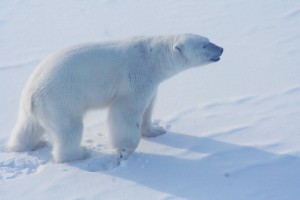1. Are polar bears egalitarian?
2. Polar bear hunting behaviour reveals broad scale distribution of ringed seal lairs
3. Pitfalls to avoid when using movement data to understand how animals search for food
1. Are polar bears egalitarian?
During competition for resources such as food, animals may interfere with one another, usually by stealing captured prey or restricting access to high quality areas through aggression. Dominance over high quality resources can be based on differences in age and sex, with younger, smaller animals subordinate to larger, older animals. Polar bears have been documented both sharing large food resources such as whale carcasses as well as stealing seal kills from one another. But how does this behavior manifest across the large home ranges polar bears occupy? Are some bears excluded from high quality areas via aggression and dominance? We used the sites of seals killed by polar bears in spring to quantify the quality of sea ice habitat and compared the locations of different classes of polar bears to this index of habitat quality. Despite being subordinate, we found subadults occupy high quality hunting areas as frequently as adults. However, adult female polar bears with cubs of the year were more likely to be excluded from high quality habitat, likely to avoid the threat of infanticide by adult males. In the spring mating season, it seems polar bears are mostly egalitarian about hunting seals, but not about mates.
Full Text:
2. Polar bear hunting behaviour reveals broad scale distribution of ringed seal lairs
Due to the difficulty in accessing offshore sea ice regions, research on ringed seal birth lairs in the spring has primarily focused on sea ice close to shore and in interisland channels. Broad scale research is difficult as ringed seals hide their pups in birth lairs beneath deep snow that has accumulated over the winter. However, polar bears may be able to help identify these cryptic lairs. Polar bears are efficient predators of ringed seal pups, precisely locating the pup through their keen sense of smell and using their tremendous power and mass to crush the roof of the lair. These attempts leave a characteristic mark on sea ice surface, observable by air. Using observations of hunting attempts across a broad scale area of both nearshore and offshore sea ice, we quantified the type of habitat ringed seal lairs were found in. Ringed seal lairs were observed across a range of ocean depths, and a considerable proportion of lairs were found in drifting pack ice. Results suggest ringed seals build lairs across a wider array of habitat types than has been previously appreciated.
Full Text:
3. Pitfalls to avoid when using movement data to understand how animals search for food
It is difficult to study animals, such as polar bears, that live in harsh and remote regions of the world. Because following such animals is challenging, scientists are increasingly using remote technology to monitor their movement. For example, the Derocher lab places on polar bears collars that give GPS location every 4 hrs. While the tracking the movement of animals may be interesting in itself (see polar bear tracker and FAQs about why we collar bears), often ecologists are interested in using the movement data to understand other behaviours. In recent years, there has been a lot of interest in understanding how animals search for food. Asking questions such as: what movement strategy do polar bears use to find seals, which are difficult to find because they are hidden under snow and unlikely to be at the exact same location from year-to-year? Scientists have proposed a few models that describe how animals move to find resources efficiently and some of these models have been associated with a lot of controversy. In this technical paper, we comment on a previous article from Drs. Michael Plank and Edward Codling (now collaborators!). We discuss the importance of comparing the most popular searching models to other strong alternatives and to verify that the suggested movement models closely reflects the observed movement of the animals studied.
Full text:


